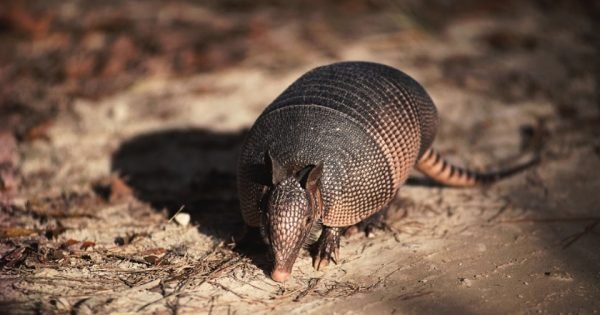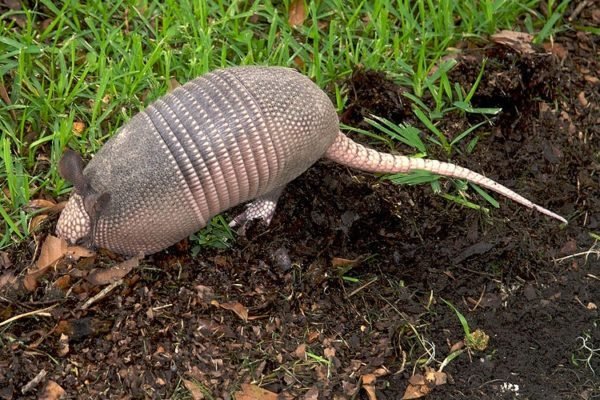Armadillo Control: Prevention & Removal

Approximately 20 armadillo species exist, but the only one found in the United States is the nine-banded one.
In Spanish, the word “armadillo” means “little armored one and refers to the presence of bony, armor-like plates that covers their bodies. Nine-banded armadillos may have 7 to 11 bands on their armor, despite their name.
A common misconception is that in spherical balls, nine-banded armadillos can roll-up. In fact, only two species (both three-banded) of armadillo can fully roll-up. Nine-banded armadillos, weighing an average of 12 pounds, are around 2.5 feet long from the nose to the tip of the tail.1Go To Source nwf.org -“Nine-Banded Armadillo”
Physical Characteristics Of The Armadillo
The size of a nine-banded armadillo is comparable to a big house cat. It has a 15-17 inch long gray to brownish-gray body. Most have scaly tails that measure between 14-16 centimeters long. They have scaly plates that cover its head, body, and tail, called scutes.
The plates are wide located on their shoulders and rumps. On its midsection, there are nine (sometimes fewer) narrow, jointed armor bands, that allow for the animal to bend.
It has a short, pointed head with a long snout, teeth that are peg-like, and big, pointed ears. There are large, strong, sharp claws on its front feet that help it dig and burrow. The bottom of the armadillo is soft, and it does have a little fur on its body, but the top is coated in armor. 2Go To Source nhpbs.org -“Nine-Banded Armadillo – Dasypus novemcinctus”
What Makes Up The Armadillo Diet?
Insects, mainly larvae, make up more than 90 percent of their diet. They also feed on earthworms, spiders, scorpions, and other invertebrates, including carrion maggots and pupas.
Other than insects, fruits and vegetables, including berries and roots, are consumed by Armadillos. Lizards, tiny frogs, rodents, and the eggs of mountain birds may be eaten if available to an armadillo. 3Go To Source dnr.sc.gov -“Armadillos”
Where Can Armadillos Be Found?
 The 9 band armadillo can be found in Central America and the southern United States. Of any existing species of armadillo, they have the largest range.
The 9 band armadillo can be found in Central America and the southern United States. Of any existing species of armadillo, they have the largest range.
In the United States, their range has been steadily expanding northwards, and they are found as far north as Missouri and even Illinois. The gravity of harsh winter weather is likely to restrict this change northward.
In the United States, their ranges have also been moving westward, and this is possibly constrained by their reliance on rainfall or other water sources.
The range expansion of nine-banded armadillos results from rising human populations and the construction of transportation routes. Wild nine-banded armadillos are abled by roads and bridges to travel over large rivers and other natural obstacles that would historically have hindered their expansion.
Human activities have also caused a decline in several natural predators of North American nine-banded armadillos. The absence of predators also contributes to their expanding range. 4Go To Source biokids.umich.edu -“Nine-Banded Armadillo”
Top 5 Human Sturcures Armadillos Use As Shelter
- Wooden Decks
- Sheds
- Garages
- Crawl Spaces
- Attics
How Armadillos Can Spread Disease To Humans?
Some armadillos are naturally infected with bacteria that cause Hansen’s disease (leprosy) in humans in the southern United States. Contact with an infected armadillo could result in the transmission of leprosy to humans.
Whenever practicable, avoid contact with armadillos for general health purposes. It can be extremely difficult to identify a diseased armadillo. Speak to your healthcare provider if you have ever had contact with an armadillo and are anxious about having Hansen’s disease. 5Go To Source cdc.gov -“Hansen’s Disease (Leprosy)”
Symptoms Of Leprosy Include:
- Discolored patches of skin that may be numb and look faded (lighter than the skin around)
- Growths (nodules) on the skin
- Skin that is dense, rigid or dry
- Painless sores on the soles of your feet
- Painless swelling on the face or earlobes
- Eyebrow deficiency or eyelashes
What Damage To The Home Will Armadillos Cause?
Most armadillo damage occurs during the animal’s search for food and includes rooting/burrowing in lawns, golf courses, vegetable gardens, and flower beds. The rooting and burrowing activity may also cause pasture harm and affect animals.
They dig shallow holes in the ground as they hunt for food. The characteristic signs of armadillo activity are shallow holes, 1 to 3 inches deep, and 3 to 5 inches wide.
When they burrow underneath foundations, driveways, decks, and other structures, they can cause structural damage. 6Go To Source extension.missouri.edu -“Armadillos in Missouri: Techniques to Prevent and Control Damage”
Armadillo Prevention Strategies
 One of the most common armadillo removal questions is how can armadillo problems be prevented? Modifying the habitat on your property can help in preventing the 9-banded armadillo. In areas with escape cover, armadillos tend to burrow, so removing brush, stumps, or other covers makes the area less armadillo friendly.
One of the most common armadillo removal questions is how can armadillo problems be prevented? Modifying the habitat on your property can help in preventing the 9-banded armadillo. In areas with escape cover, armadillos tend to burrow, so removing brush, stumps, or other covers makes the area less armadillo friendly.
Armadillos have the potential for climbing and burrowing. Fencing or barriers can exclude armadillos from unwanted areas. A fence slanted outward at a 40-degree angle, with the bottom portion buried, can prevent burrowing.
Armadillos may attempt to burrow under structures such as decks, garages, and sheds. Stacking chicken wire flat around the foundation on the ground may prevent further burrowing. 7Go To Source uaex.edu -“Armadillos and Their Control in Arkansas”
Ill-informed homeowners may purchase armadillo repellents such as castor oil, mothballs, predator urine to get rid of armadillos. Most repellents will prove to be ineffective and will not work.
Removing Armadillos On Your Property
Armadillo Trapping and armadillo removal can be tricky. Without adequate protection, handling armadillos can lead to scratches and increase the risk of contracting an unwanted illness.
The best way to ensure the homeowner’s and the animal’s welfare is to ensure the armadillos do not find their way back to the property. An experienced armadillo removal service will have the ability to ensure animal removal is completed correctly.
Wildlife removal professionals also can repair animal damages and armadillo proof the property. If the homeowner is inexperienced with wildlife control, it may be beneficial to contact a removal expert before making a decision.
Sources:
- Nine-Banded Armadillo. (n.d.). Retrieved December 03, 2020, from https://www.nwf.org/Educational-Resources/Wildlife-Guide/Mammals/Nine-Banded-Armadillo
- Nine-Banded Armadillo – Dasypus novemcinctus – NatureWorks. (n.d.). Retrieved December 03, 2020, from https://nhpbs.org/natureworks/armadillo.htm
- National Wildlife Control Training Program. (n.d.). Armadillos. Retrieved December 03, 2020, from https://www.dnr.sc.gov/wildlife/publications/nuisance/armadillos.pdf
- Web, A. (n.d.). Critter Catalog. Retrieved December 03, 2020, from http://www.biokids.umich.edu/critters/Dasypus_novemcinctus/
- Transmission. (2017, February 10). Retrieved December 03, 2020, from https://www.cdc.gov/leprosy/transmission/index.html
- Pierce II, R. (2012, January). Armadillos in Missouri: Techniques to Prevent and Control Damage. Retrieved December 03, 2020, from https://extension.missouri.edu/publications/g9456
- McPeake, R. (n.d.). Armadillos and Their Control in Arkansas. Retrieved December 03, 2020, from https://www.uaex.edu/publications/pdf/FSA-9109.pdf
